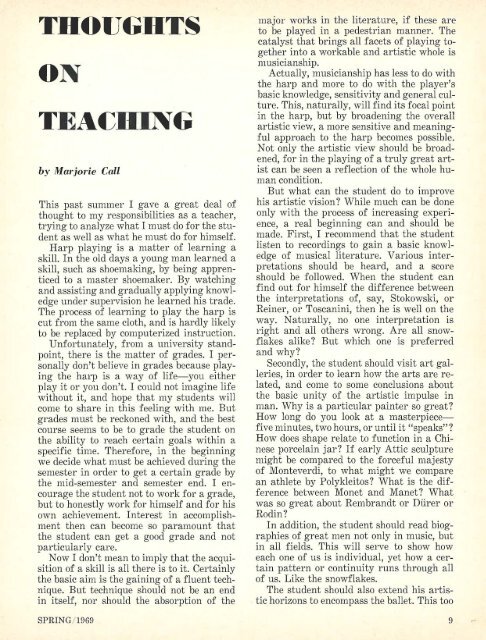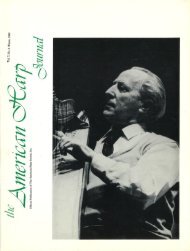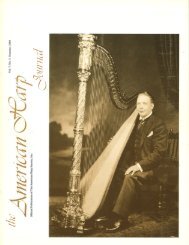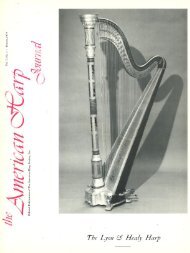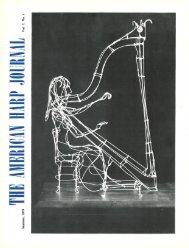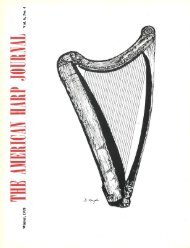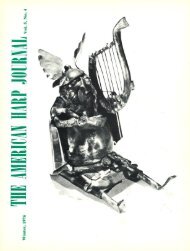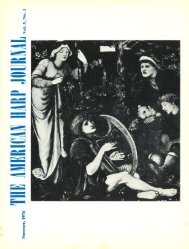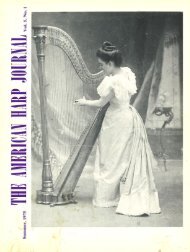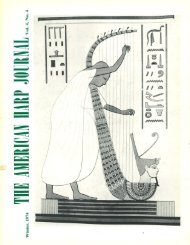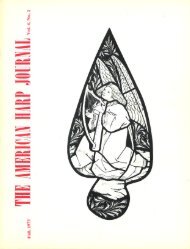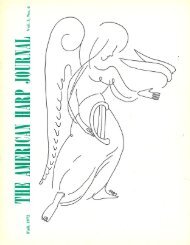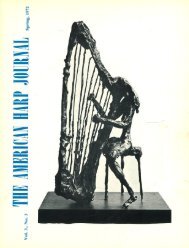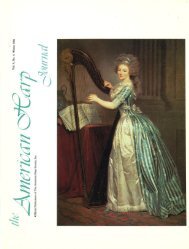AHJ, Vol. 2 No. 1, Spring 1969
AHJ, Vol. 2 No. 1, Spring 1969
AHJ, Vol. 2 No. 1, Spring 1969
Create successful ePaper yourself
Turn your PDF publications into a flip-book with our unique Google optimized e-Paper software.
TIIOUGIITS<br />
ON<br />
TEACHING<br />
by Marjorie Call<br />
This past summer I gave a great deal of<br />
thought to my responsibilities as a teacher,<br />
trying to analyze what I must do for the student<br />
as well as what he must do for himself.<br />
Harp playing is a matter of learning a<br />
skill. In the old days a young man learned a<br />
skill, such as shoemaking, by being apprenticed<br />
to a master shoemaker. By watching<br />
and assisting and gradually applying knowledge<br />
under supervision he learned his trade.<br />
The process of learning to play the harp is<br />
cut from the same cloth, and is hardly likely<br />
to be replaced by computerized instruction.<br />
Unfortunately, from a university standpoint,<br />
there is the matter of grades. I personally<br />
don't believe in grades because playing<br />
the harp is a way of life-you either<br />
play it or you don't. I could not imagine life<br />
without it, and hope that my students will<br />
come to share in this feeling with me. But<br />
grades must be reckoned with, and the best<br />
course seems to be to grade the student on<br />
the ability to reach certain goals within a<br />
specific time. Therefore, in the beginning<br />
we decide what must be achieved during the<br />
semester in order to get a certain grade by<br />
the mid-semester and semester end. I encourage<br />
the student not to work for a grade,<br />
but to honestly work for himself and for his<br />
own achievement. Interest in accomplishment<br />
then can become so paramount that<br />
the student can get a good grade and not<br />
particularly care.<br />
<strong>No</strong>w I don't mean to imply that the acquisition<br />
of a skill is all there is to it. Certainly<br />
the basic aim is the gaining of a fluent technique.<br />
But technique should not be an end<br />
in itself, nor should the absorption of the<br />
SPRING <strong>1969</strong><br />
major works in the literature, if these are<br />
to be played in a pedestrian manner. The<br />
catalyst that brings all facets of playing together<br />
into a workable and artistic whole is<br />
111 usicianship.<br />
Actually, musicianship has less to do with<br />
the harp and more to do with the player's<br />
basic knowledge, sensitivity and general culture.<br />
This, naturally, will find its focal point<br />
in the harp, but by broadening the overall<br />
artistic view, a more sensitive and meaningful<br />
approach to the harp becomes possible.<br />
<strong>No</strong>t only the artistic view should be broadened,<br />
for in the playing of a truly great artist<br />
can be seen a reflection of the whole human<br />
condition.<br />
But what can the student do to improve<br />
his artistic vision? While much can be done<br />
only with the process of increasing experience,<br />
a real beginning can and should be<br />
made. First, I recommend that the student<br />
listen to recordings to gain a basic knowledge<br />
of musical literature. Various interpretations<br />
should be heard, and a score<br />
should be followed. When the student can<br />
find out for himself the difference between<br />
the interpretations of, say, Stokowski, or<br />
Reiner, or Toscanini, then he is well on the<br />
way. Naturally, no one interpretation is<br />
right and all others wrong. Are all snowflakes<br />
alike? But which one is pref erred<br />
and why?<br />
Secondly, the student should visit art galleries,<br />
in order to learn how the arts are related,<br />
and come to some conclusions about<br />
the basic unity of the artistic impulse in<br />
man. Why is a particular painter so great?<br />
How long do you look at a masterpiecefive<br />
minutes, two hours, or until it "speaks"?<br />
How does shape relate to function in a Chinese<br />
porcelain jar? If early Attic sculpture<br />
might be compared to the forceful majesty<br />
of Monteverdi, to what might we compare<br />
an athlete by Polykleitos? What is the difference<br />
between Monet and Manet? What<br />
was so great about Rembrandt or Diirer or<br />
Rodin?<br />
In addition, the student should read biographies<br />
of great men not only in music, but<br />
in all fields. This will serve to show how<br />
each one of us is individual, yet how a certain<br />
pattern or continuity runs through all<br />
of us. Like the snowflakes.<br />
The student should also extend his artistic<br />
horizons to encompass the ballet. This too<br />
9


